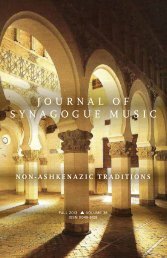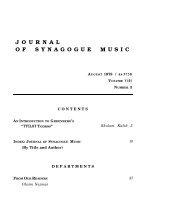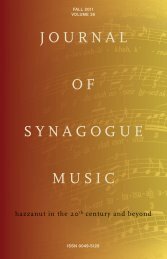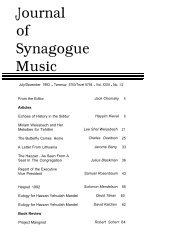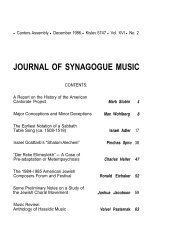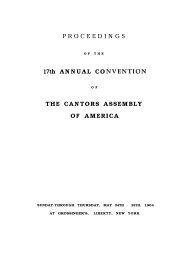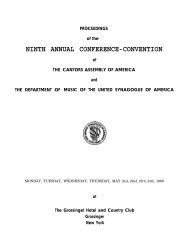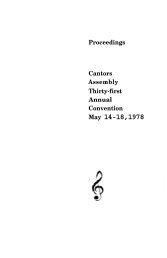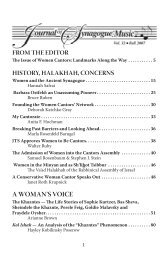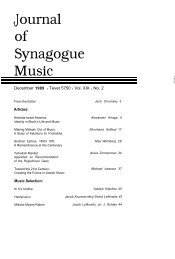Volume 7, Number 3 - Cantors Assembly
Volume 7, Number 3 - Cantors Assembly
Volume 7, Number 3 - Cantors Assembly
Create successful ePaper yourself
Turn your PDF publications into a flip-book with our unique Google optimized e-Paper software.
English is his third language (after Yiddish and Hungarian) and<br />
his secular education was limited and, in many ways, quite informal.<br />
However, he is a voracious reader, has an excellent memory and thus<br />
he overcame any gaps in his formal education. I have always marveled<br />
at how well read he is, at his extensive vocabulary, his impeccable<br />
grammar, and the absence of any foreign accent in his speech. These<br />
are all thing which he taught himself. It was in this same intense, but<br />
informal manner, that he taught himself music and music theory.<br />
He decided to become a cantor at the age of 16 when, on the High<br />
Holy Days, the cantor in whose choir he had been singing became ill.<br />
Knowing the music and the service thoroughly, and being at home on<br />
the pulpit, he had no difficulty in stepping in, despite his youth.<br />
Pop has always had an unusual combination of ability and nerve,<br />
which he often used to compensate for his lack of experience, or to<br />
make an impression when it was necessary. He used to like to audition<br />
for a position without using music and without opening the siddur<br />
since he knew both by heart. This never failed to make an impression<br />
and to have the desired effect. In one instance, early in his career, he<br />
even undertook to serve as hazzan and to fill the rabbinic function for a<br />
congregation, even preaching in English, although he was still struggling<br />
with the language and had had no training or experience for such a<br />
role.<br />
Typically, he decided early in his career that he had to be not only<br />
a good cantor but an expert in the field. He set himself the task of<br />
reading everything available on the subject of hazzanut. Much of this<br />
reading was done, as with many other immigrants, in the New York<br />
Public Library. Methodically, he read through the Talmudic and<br />
Midrashic references, the other classical sources, and everything<br />
modem that he could find. The copious notes which he developed in<br />
those years are a rich treasure of background information which serve<br />
as a basis for his teaching and lecturing to this day.<br />
He has always approached hazzanut with a serious attitude,<br />
taking it not himself, seriously a nd conducting himself in the most<br />
professional manner. At the same time, he has always had a great sensitivity<br />
to the congregation - its needs, abilities and likes. As those<br />
attending the synagogue became less familiar with davening and less<br />
appreciative of and responsive to the European styles, he began to<br />
seek new ways of making the service uplifting and spiritally meaningful<br />
without sacrificing the nusah and the traditional forms. This<br />
approach is certainly reflected in his most recent compositions, which<br />
are for cantor and congregation. He clearly understands the factors<br />
and processes of change in American life and their effect on the<br />
synagogue and the Jew.<br />
29



